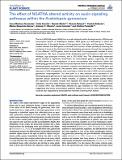Por favor, use este identificador para citar o enlazar a este item:
http://hdl.handle.net/10261/147770COMPARTIR / EXPORTAR:
 SHARE SHARE
 CORE
BASE CORE
BASE
|
|
| Visualizar otros formatos: MARC | Dublin Core | RDF | ORE | MODS | METS | DIDL | DATACITE | |

| Título: | The effect of NGATHA altered activity on auxin signaling pathways within the Arabidopsis gynoecium |
Autor: | Martínez Fernández, Irene CSIC ORCID; Sanchís, Sofía; Marini, Naciele; Balanza Pérez, Vicente CSIC ORCID; Ballester, Patricia CSIC; Navarrete-Gómez, Marisa CSIC; Oliveira, Antonio C. de; Colombo, Lucia; Ferrándiz, Cristina CSIC ORCID | Palabras clave: | Gynoecium development NGATHA Auxin synthesis Auxin transport Auxin response factors |
Fecha de publicación: | 21-may-2014 | Editor: | Frontiers Media | Citación: | Frontiers in Plant Science 5: 210 (2014) | Resumen: | The four NGATHA genes (NGA) form a small subfamily within the large family of B3-domain transcription factors of Arabidopsis thaliana. NGA genes act redundantly to direct the development of the apical tissues of the gynoecium, the style, and the stigma. Previous studies indicate that NGA genes could exert this function at least partially by directing the synthesis of auxin at the distal end of the developing gynoecium through the upregulation of two different YUCCA genes, which encode flavin monooxygenases involved in auxin biosynthesis. We have compared three developing pistil transcriptome data sets from wildtype, nga quadruple mutants, and a 35S::NGA3 line. The differentially expressed genes showed a significant enrichment for auxin-related genes, supporting the idea of NGA genes as major regulators of auxin accumulation and distribution within the developing gynoecium. We have introduced reporter lines for several of these differentially expressed genes involved in synthesis, transport and response to auxin in NGA gain- and loss-of-function backgrounds. We present here a detailed map of the response of these reporters to NGA misregulation that could help to clarify the role of NGA in auxin-mediated gynoecium morphogenesis. Our data point to a very reduced auxin synthesis in the developing apical gynoecium of nga mutants, likely responsible for the lack of DR5rev::GFP reporter activity observed in these mutants. In addition, NGA altered activity affects the expression of protein kinases that regulate the cellular localization of auxin efflux regulators, and thus likely impact auxin transport. Finally, protein accumulation in pistils of several ARFs was differentially affected by nga mutations or NGA overexpression, suggesting that these accumulation patterns depend not only on auxin distribution but could be also regulated by transcriptional networks involving NGA factors. | Versión del editor: | http://doi.org/10.3389/fpls.2014.00210 | URI: | http://hdl.handle.net/10261/147770 | DOI: | 10.3389/fpls.2014.00210 | ISSN: | 1664-462X |
| Aparece en las colecciones: | (IBMCP) Artículos |
Ficheros en este ítem:
| Fichero | Descripción | Tamaño | Formato | |
|---|---|---|---|---|
| fpls-05-00210.pdf | Artículo principal | 1,14 MB | Adobe PDF |  Visualizar/Abrir |
CORE Recommender
PubMed Central
Citations
17
checked on 19-abr-2024
SCOPUSTM
Citations
41
checked on 23-abr-2024
WEB OF SCIENCETM
Citations
41
checked on 23-feb-2024
Page view(s)
287
checked on 24-abr-2024
Download(s)
224
checked on 24-abr-2024

